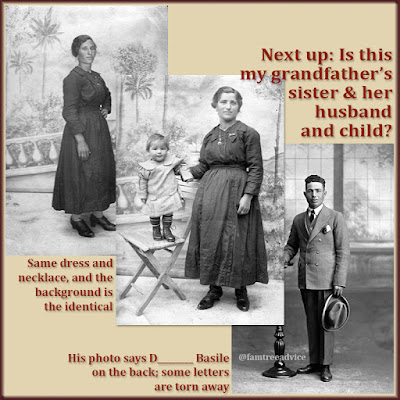Everyone who dabbles in family tree building has hit one or more brick walls.
After thinking about my own dead ends, I realized brick walls fall into a few main categories. I've named 4 of them below. Each type has several potential brick wall-busting documents. Have you found them all?
 |
| Focus on the type of brick wall, then think of all the documents than can break it down. |
Brick Wall #1: What Was Her Maiden Name?
Can you imagine if women all around the world kept their maiden name for life? That's what women in Italy do. But I suppose if that were the case, our brick walls would be What Was Her Married Name?
If you have a female with a missing maiden name, and you can't find her death record, do all you can to find these documents:
- A marriage record under her married name.
- The death record for each of her children. One or more may have her maiden name.
- Social Security applications and pension records. I found a mangled version of my 2nd great grandmother's maiden name this way. It pointed me in the right direction.
- Obituaries for close family members. I haven't found an obit for any of my relatives beyond my parents' generation. But you may get lucky.
Brick Wall #2: Who Were Their Parents?
Let's say you've got this relative in the 1900 U.S. Census, but you don't know who their parents were. Maybe it's a woman with no maiden name available. Or a man with such a common name, you can't be sure which man is him.
Be sure to do an exhaustive search for all these documents:
- Their death record. Beware: the person who supplied the information on the death record may not have known the facts you want. (See 27 Key Facts to Extract From a Death Certificate.)
- Draft registration cards or other military records. I found the World War II missing flight record for my uncle who crashed and died. It lists the name and address of the nearest relative of all 10 crew members. (See Was Your Ancestor in the Military? It May Not Matter.)
- Every census record. Their parent may be living with them.
- Passport applications.
- Citizenship papers. Sometimes you'll find a lot of very specific family details on these documents.
- Immigration records. There's definitely a sweet spot for immigration records. If they immigrated earlier than the late 1890s, you may not learn any more than which country they came from.
Brick Wall #3: Where Did They Come From?
Someone asked for my help with this type of brick wall recently. Their ancestor had a clearly made-up name and seemed to drop right out of the sky.
All we could do was search for the following types of records:
- Their immigration record. (He came here too early for details.)
- Citizenship papers.
- A marriage record. This may list only the person's country of origin, but sometimes it includes the town.
- Their death record. If you're lucky, the informant knew the deceased's parents' names.
 |
| Just as it takes many bricks to make a wall, it takes many facts and documents to tear down that wall. |
Brick Wall #4: Where Did They Go?
This is the type of brick wall on my mind this week. Where did my grandfather's younger brother go? I have nothing but his birth record, so I started thinking about everything else I can search for:
- His marriage record. There isn't one available from his Italian hometown, but he may have married:
- during a year with no marriage records available
- in another town, or
- not at all.
- His death record. There is no record of his death in his hometown in the years with available documents.
- An immigration record. My great uncle's name was Noé—that's Noah in English—Leone. There isn't a single record of any kind for any variation of his name anywhere. Only his Italian birth record. That finding rules out all other main genealogy documents for this uncle.
- Military records. I checked to see if my uncle died in Italy in World War I or World War II. He did not. There's a Benevento province website where I can look up all the Italian men with military service—which was all the men. Since Noé isn't listed there, it's very likely he died before he turned 20 years old. Unfortunately, his town's 1910–1915 death records are not available online. Someday I'll return to the Benevento Archives and search the death records in person.
 |
| Did my great uncle leave town forever? I don't know what became of him. |
This may not be a complete list. But seeing brick walls boiled down to their basic types should help you know what your options are. If you can't retrieve the records you need on your own, consider seeking a professional's help. I hired a pair of researchers in Italy to gather church records from my ancestors' town. I've actually been to that church, but I wasn't able to access their records on my own.
People often comment that "not all genealogy records are online." I wish they were! Even when the world wasn't screeching to a halt, I wasn't able to travel anywhere at any time. I'd like to spend a few days researching in Hornell, New York. And a few days in Girard, Ohio. And months on end in several small towns in Italy. But I don't want my family tree work to wait for future research trips.
When Italian vital records came online 3 years ago, my tree blossomed in countless directions. It's my hope that Italy will digitize their parish records in my lifetime. But if that doesn't happen, I'm satisfied that I've done all I can to break through my brick walls. For now.





